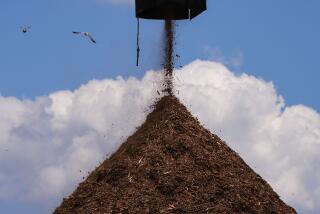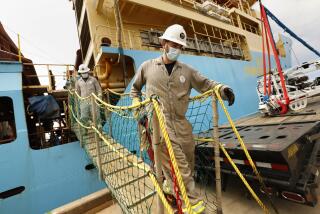Environmentalists Seek Smelter Cleanup : Suit Adds to Copper Firms’ Woes
TUCSON — The copper industry, with its production on the skids due to foreign competition and its job force shrinking, now faces another problem: environmentalists are renewing demands for costly smelter cleanup.
Arizona is the leading domestic producer of copper--a popular metal used in a large variety of goods, including telephone circuits, homes and cars.
Domestic companies complain that foreign copper producers have taken advantage of America’s costly environmental regulations to dump low-price exports on the U.S. market.
They note that copper imports have soared 122% since 1979, while 38% of all copper workers in the nation and 52% in Arizona have lost their jobs.
Copper Prices Plummeted
As a result of the surge in imports, they say, copper prices plummeted and U.S. producers found their profit margins falling below the break-even point. Layoff notices went out, food stamp lines grew and the bleak Arizona desert sprouted new ghost towns.
Unemployment in the state’s copper industry is now chronic, industry executives say, and no quick turnaround is expected.
So it was a blow to the industry when the Environmental Defense Fund in November, 1984, chose two Arizona smelters as targets for a new lawsuit.
The Denver-based group filed a federal suit against Phelps Dodge Corp. and Magma Copper Co. demanding cleanup of their Douglas and San Manuel smelters and claiming that the operations have violated the Clean Air Act.
“The industry has done its very best to comply with the Clean Air Act,” countered C. J. Hansen, president of the Arizona Mining Assn.
“We have spent over one-half billion dollars already and have more money budgeted for air quality control equipment,” he said.
The Environmental Defense Fund says the need for new jobs in Arizona must be balanced against the need for clean air.
But Hansen said a major problem in controlling pollution from smelters is that the technology is expensive and unproven.
“It has to be tested at each smelter because conditions at each of them are different,” he said. “What works in one place won’t work in another.”
A private environmental consultant said there’s a good reason for singling out the two smelters in the suit.
“This is not an attack on the entire copper industry,” says Priscilla Robinson of Tucson-based Southwest Environmental Service.
“It’s not fair to the rest of the industry that has invested money in cleanup to allow these two smelters to escape. It’s an issue of equity in the industry.
“There are seven smelters in Arizona and five of them have either completed their modernization or will be within a matter of months. So these are the only two Western smelters that are continuing to operate and have not met the emission standards,” Robinson said.
Others say the industry needs to do a better job of explaining its problems to Congress.
“I don’t think the current environmental laws make sense,” said George Leaming, a private economics consultant in Marana, Ariz. “The copper industry has made a mistake in trying to be a ‘responsible citizen’ and complying with the act. What it should be doing is working to change the laws.
“The biggest problem is trying to comply with unreasonable laws in the first place,” Leaming says. “Copper smelters have been trying to keep the air clean for a long time. Trying to comply with the Clean Air Act has been almost disastrous to the industry.”
Arizona accounted for 65.3% of total U.S. copper production in 1983--producing 747,757 tons valued at about $1.1 billion. However, this was the lowest production level since 1973.
Sen. Dennis DeConcini (D-Ariz.) is sympathetic to claims that unfair foreign competition is forcing mine closures across the nation. In early December, 1984, he urged President Reagan to impose a U.S. boycott on copper from Chile.
“A U.S. boycott of Chilean copper would also send a clear signal of protest to this country, which continues to subsidize its copper production, ship its surplus to us and disrupt our free-market system,” DeConcini said.
Arizona’s congressional delegation also has urged, without much success, that the federal government stockpile copper for strategic purposes so that the United States would not be dependent on foreign supplies in the event of an international crisis.
When El Paso & Southwestern railroad built its copper-hauling railroad from Douglas into Tucson in the early 1900s, no one was too worried about smelter pollution.
Much of the railroad is now torn up, but the mining and smelter towns it served near Mexico remain--part of the so-called Gray Triangle where pilots must plow their crafts through tons of airborne sulfur dioxide.
By next year, two smelters in northern Mexico and a Phelps Dodge facility in Douglas could pour 2,700 tons of sulfur dioxide into the atmosphere daily.
That would be equal to 80% of all the sulfur dioxide produced in the West, including that from coal-fired power plants.
The projections alarm environmentalists. They point out that sulfur dioxide is the key ingredient in acid rain, which damages forests, other vegetation and even buildings.
In December, a coalition of environmental organizations calling itself GASP--Groups Against Smelter Pollution--announced that it would launch a petition drive urging a legislative crackdown on smelter emissions in the Gray Triangle.
In the depths of the 1981-82 economic recession, sulfur dioxide pollution in the West decreased by 50%--about equal to the decrease in copper production--said Bob Yunke of the Environmental Defense Fund.
He said Phelps Dodge plans to close its aging Douglas smelter, which was built to serve the now-closed mines at nearby Bisbee. The smelter “has basically outlived its ore body,” Yunke says.
Phelps Dodge closed a smelter at Clifton, Ariz. on Sunday, but the closing did not occur without violence. Youths hurled rocks at cars driven by 350 workers, hired to replace employees who went on strike in July,1983. No injuries or arrests were reportred. A mine nearby remains open.
More to Read
Sign up for Essential California
The most important California stories and recommendations in your inbox every morning.
You may occasionally receive promotional content from the Los Angeles Times.










